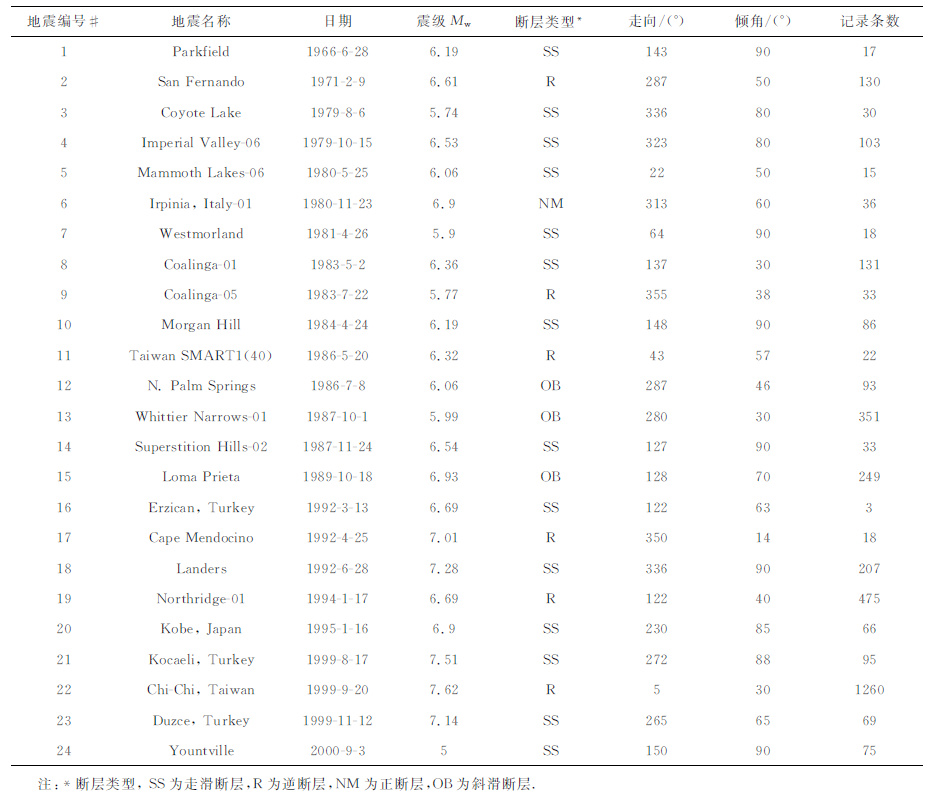2. "中央"大学地球物理研究所, 台湾 32001
2. Strong Motion Lab, Institute of Geophysics, National Central University, Taiwain 32001, China
Berrero等[1]研究了1971 年SanFernando 地震记录后首次指出,近断层地震动中含有大幅值、长周期的速度脉冲,这种脉冲对结构具有特殊的破坏作用.随后,在1979 年ImperilaValley 地震、1992年Landers 地震、1994 年Northridge 地震以及1995年日本Kobe地震等都观测到这种脉冲型近断层记录.结构地震分析的研究表明地震动时程的这种长周期速度脉冲与结构大的层间位移密切相关,大幅值长周期的速度脉冲会对某一固有周期的结构造成很大的层间位移和永久变形[2-6].另一方面,这种长周期速度脉冲的形成与断层破裂的方向性效应和断层逆冲机制引起的永久位移密切相关[7-9].因而,近断层速度脉冲受到地震学和地震工程研究的广泛关注.
目前,关于速度脉冲的地震动特性的研究主要是根据近断层脉冲记录进行统计分析.Alavi & Krawinkler[10]研究认为速度脉冲的周期与地震动速度反应谱的峰值周期近似一致,由8 条近断层记录数据回归得到了脉冲周期和震级的关系模型,分析结果表明速度脉冲的周期是随震级的增大而增加的.Somerville[11]利用15 条基岩场地和12 条土层场地上的典型脉冲型记录进行回归,分别得到的基岩和土层场地上脉冲周期随震级变化的关系,研究表明在土层场地得到速度脉冲周期略大于基岩场地.Mavroeidis & Papageorgiou [12]利用42 条脉冲记录统计得到脉冲周期与震级的关系,分析了断层不同类型对脉冲周期的影响,研究表明走滑断层的脉冲周期要比逆断层大,而斜滑断层的脉冲周期介于走滑断层和逆断层之间.Bray & Rodriguez[13]利用54条近断层速度脉冲记录回归得到了不同场地上脉冲的幅值和周期随震级、距离变化的关系,并对平行断层方向和垂直断层方向的速度脉冲进行比较,结果表明沿平行断层方向与沿垂直断层方向的速度脉冲幅值的比值约为0.65,而沿平行断层方向速度脉冲的周期约为沿垂直断层方向的0.85倍.韦韬等[14]利用Chi-Chi地震和Northridge地震的近断层记录对速度脉冲记录和非脉冲记录的反应谱和特征周期进行了对比分析,研究发现在长周期段(>1.5s),速度脉冲记录的反应谱值要比无脉冲记录的反应谱值大,速度脉冲记录的特征周期比我国规范的Ⅰ类和Ⅱ类场地给出的特征周期值要大,达到规范值的2倍以上.然而,目前的研究在统计分析时在对近断层脉冲型记录进行判别时主要依靠直观经验,这可能会给统计分析的结果带来较大误差[15].
2008年汶川Ms8.0 级地震中,中国数字强震动观测台网获取到大量的近场强震加速度记录[16-18],许多近场记录具有明显的速度脉冲特征[19-21],这些强震记录为近断层速度脉冲的地震动特性研究提供了非常宝贵的资料.小波分析是一种信号的时间-尺度或时间-频率的分析方法,具有很高的分辨率,研究表明小波分析在时、频两域都具有表征信号局部瞬态特征的能力[22-23].本文将利用小波方法分析汶川地震近断层速度脉冲的地震动特性,以db4 小波为母波函数从强震记录中提取长周期信号,依据脉冲型记录判定准则对近断层记录进行分类,统计分析速度脉冲的周期和幅值特征,研究震级、距离对脉冲周期和幅值等参数的影响.
2 强震记录数据选取汶川地震中断层距小于200km 的64 组强震记录(强震台站分布如图 1),基于小波分析方法将强震记录按照脉冲和非脉冲特征进行分组,分析汶川地震近断层地震动的速度脉冲特性.同时,为了分析汶川地震中地震动的速度脉冲特点,将汶川地震的速度脉冲与以往地震进行对比,利用NGA数据库24次地震事件中的3615 条记录(见表 1),选取出典型的脉冲型记录作为统计分析的基础数据,研究脉冲周期和幅值等参数的统计特性,分析速度脉冲特性和震源参数的关系.

|
图 1 汶川地震64个强震数据台站的分布 Fig. 1 Location of 64 near-fautt strong motionstations during Wenchuan earthquake |
|
|
表 1 选取的NGA数据库中24个地震事件的主要参数 Table 1 24 earthquake events from NGA database used in the study of near-fault ground motion |
鉴于脉冲型地震动对工程结构的特殊破坏作用,研究学者往往将近断层地震动按照脉冲和非脉冲分组进行对比研究[24-26],然而实际上,许多近断层记录很难直观地进行分组.图 2 中给出的汶川地震中获取到的近断层记录时程,(a、b、c、d)分别为51MZQ 台、51JYT 台、51JYC 台和51WCW 台记录的垂直断层方向的速度波形.对于51MZQ 台FN分量记录可以比较直观地判断为脉冲型记录,而对于51JYT 台、51JYC 台FN 分量记录利用直观判断则比较困难.

|
图 2 汶川地震中获取到的近断层地震动速度波形 Fig. 2 Velocity trace of near-fault strong motions during Wenchuan earthquake |
小波分析是一种信号的时间-尺度或时间-频率的分析方法,即在时域对信号进行离散变换,在频域进行谱分析的方法.小波具有很高的分辨率,在时、频两域都具有表征信号局部特征的能力,是分析瞬态时变地震动信号的一种非常有效的工具[22-23].可以利用小波分解的方法从地震动记录中提取其所包含的最大脉冲信号,图 3 中给出了几种常用的小波分析的母波函数.由于Daubechies小波的波形与地震动速度脉冲波形非常相似,在提取地震动脉冲时相比其它母波函数有更高的稳定性,本文选取4阶Daubechies小波对选取的64组地震动记录做一维连续小波变换,提取原始地震动速度时程中的长周期脉冲信号.将强震记录沿垂直断层和平行断层方向进行投影,统计分析垂直断层分量(FNcomponent)和平行断层分量(FPcomponent)速度脉冲的地震动特性.参考Baker[15]提出的脉冲型记录的判定方法,对汶川地震的64组地震动记录进行分组,选取的脉冲型记录需满足3个条件:

|
图 3 常用的母波函数 (a)Haar小波;(b)1阶Gaussian 小波;(c)4阶Daubechies小波;(d)Morlert小波. Fig. 3 Common mother wavelets used for wavelet analysis (a) Haar wavelet; (b) The first order Gaussian wavelet;(c) The fourth order Daubechies wavelet; (d) Morlet wavelet. |
(1) 原始的速度记录具有简单的长周期脉冲信号特征.判定的方法是,计算提取出脉冲信号后的剩余波形的PGV 和原始记录PGV 的比值,以及剩余波形的能量和原始波形记录能量的比值(能量可以由速度平方求积分得到),必须满足:

|
(1) |
上式中PGVratio为提取出脉冲信号后的剩余波形信号的PGV 和原始记录的PGV 的比值,Eratio为剩余波形信号的能量和原始记录的能量的比值.当该值在大于0.85和小于0.15 时,地震动记录分别为脉冲型和非脉冲型[15].图 4 所示,左图和右图分别是采用db4小波对江油含增台(51JYH)平行断层分量(FP分量)和垂直断层分量(FN 分量)提取长周期信号的结果.图中(a、b、c)分别为原始记录、提取出的脉冲信号和提取出脉冲信后的剩余波形,计算得到51JYH 台FP分量和FN 分量的这两条记录的判定参数(Pulseindicator)分别为0.05和0.86,台站51JYH 的FN分量满足脉冲型记录的第1个条件,而51JYH 台FP分量的判定参数Pulse indicator<0.15,不满足简单脉冲特征,在统计脉冲型记录时应将51JYH 台FP分量记录去除.
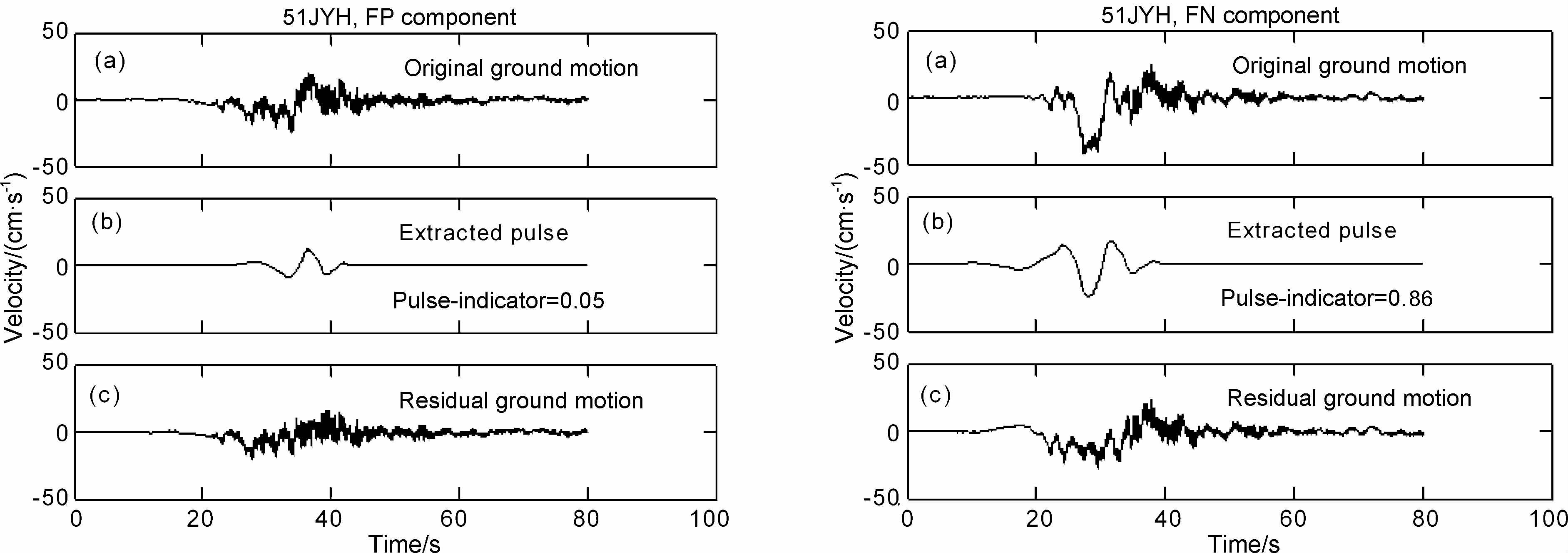
|
图 4 采用db4小波对51JYH 台FP分量和FN 分量提取长周期脉冲信号的结果 Fig. 4 Extracted long period pulse signal from FP and FN component of 51 JYH record using wavelet method |
(2) 由方向性效应和滑冲效应引起的近断层速度脉冲应出现在地震动波形的早期.判定的方法是,分别计算提取出的脉冲信号和原始速度波形的累积平方速度(Cumulative squared velocity, CSV)随时间变化的函数,即能量时间函数

|
(2) |
速度脉冲出现在地震动波形的早期需满足提取出的脉冲信号达到总能量10% 的时刻t10%, pulse出现在原始记录达到总能量20%的时刻t20%, orig之前,即

|
(3) |
图 5对早到脉冲和晚到脉冲进行了对比,图中(A、B)分别为德阳白马台(51DYB)FP 分量和大邑银屏台(51DYX)FP 分量.由t10%, pulse和t20%, orig的大小关系可以判断51DYB 台FP 分量满足早到脉冲的条件,而51DYX 台FP 分量属于晚到脉冲,在统计脉冲型记录时应将该记录去除.
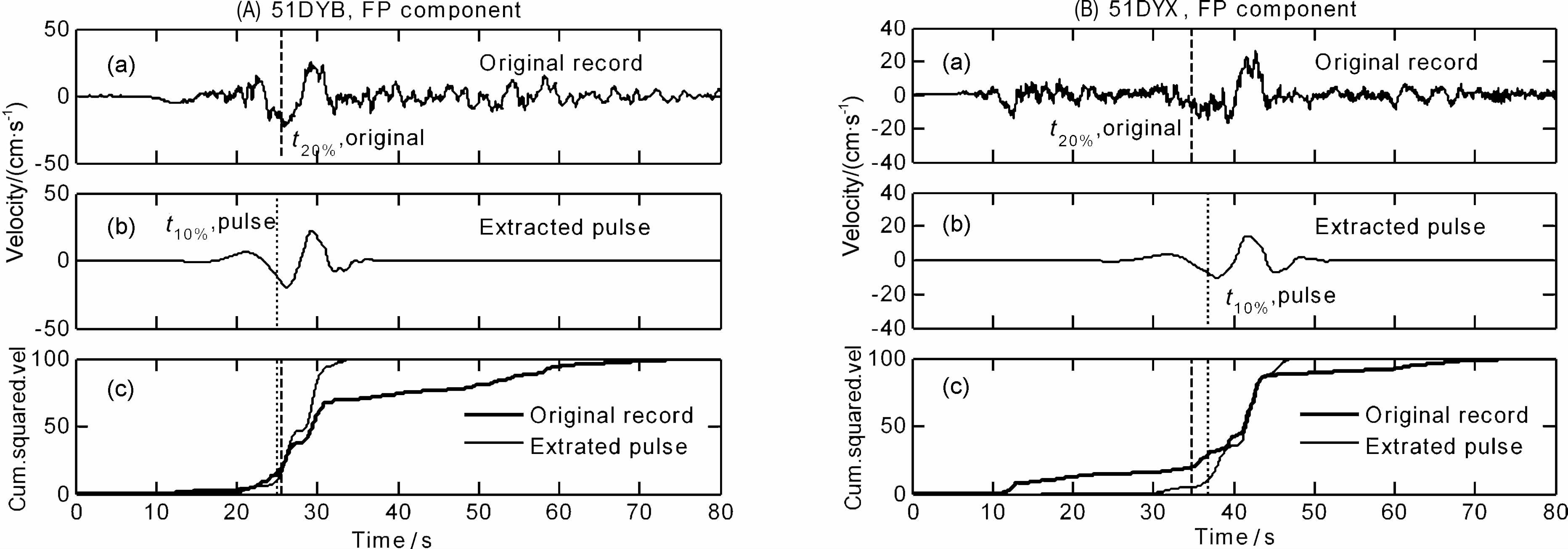
|
图 5 早到脉冲(A)和晚到脉冲(B)的对比图解 (a)原始记录;(b)提取出的脉冲信号;(c)累积平方速度. Fig. 5 Illustration of an early-arriving pulse(A) and a late-arriving pulse (B) (a) Original ground motion; (b) Extracted pulse; (c) Cumulative(Cum. ) squared velocities. |
(3) 原始记录的速度峰值不能太小,对于脉冲型记录必须满足原始速度峰值大于30cm/s, 即PGV>30cm/s.
4 速度脉冲周期和幅值特性速度脉冲是引起近断层结构破坏的重要原因之一.多自由度体系在脉冲作用下的弹性和非弹性反应分析表明,脉冲的幅值和周期是控制结构变形的主要参数[27-29].因而,速度脉冲幅值和周期参数的研究在工程上受到很大关注.
依据上节脉冲型记录的判定方法对汶川地震中的64组记录进行筛选,共选取到了垂直断层和平行断层方向的7 条脉冲型记录(判定指数Pulseindicator>0.85),这7条脉冲型记录的速度波形如图 6所示.表 2列出了这7 条脉冲型记录的主要参数,脉冲幅值最大的是51MZQ 台的FN 分量,达到了126.1cm/s.这7 条记录的脉冲周期为6.5~14.2s, 最大的脉冲周期是51MZQ 台的FP 分量,达到了14.2s.比较可以发现,同一台站记录到的地震动垂直断层的分量(FN 分量)的脉冲幅值比平行断层分量(FP分量)要大,如51MZQ 台、51JYH 台垂直断层分量的幅值分别为126.1cm/s和33.3cm/s, 而其平行断层分量的幅值分别仅为85.9cm/s 和30.5cm/s.
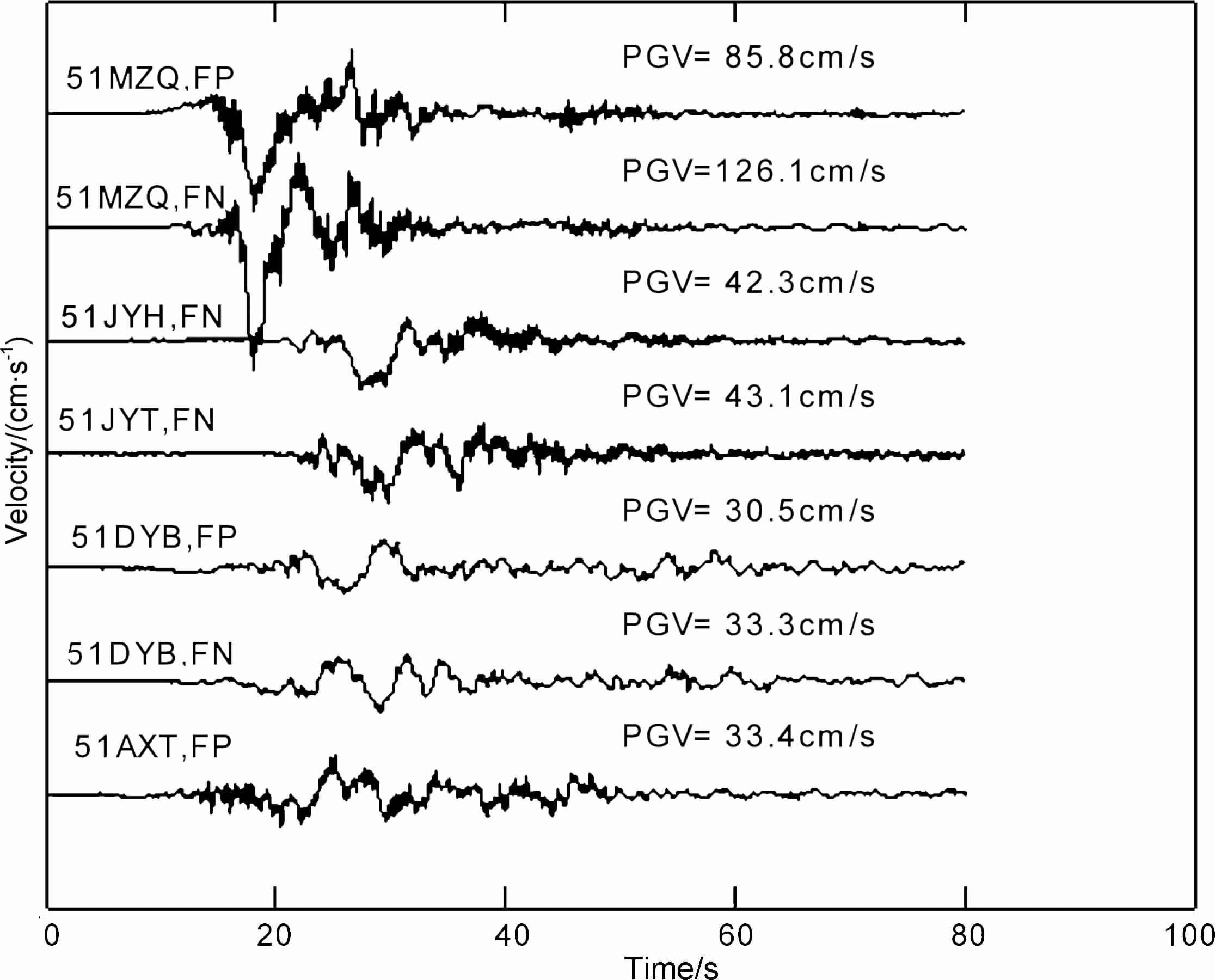
|
图 6 汶川地震64组强震记录中获取到的脉冲型记录的速度波形 Fig. 6 Time histories of distinct velocity pulses obtained from 64 groupsof strong motion records during Wenchuan earthquake |
|
|
表 2 汶川地震中的脉冲型记录的主要参数(pulse indicator >0. 85) Table 2 Parameters of selected velocity pulses from Wenchuan earthquake with pulse indicator >0.85 |
图 7给出了这次地震中获取到脉冲型记录的强震台站和非脉冲台站的分布.震源破裂过程研究表明汶川地震是一次沿地震断层朝北东向单侧破裂为主的逆冲破裂事件[30-32].由图 7可见,脉冲型记录台站均位于沿着断层破裂传播的方向上,且这些台站与地表断裂的距离都在小于30km 的范围(51DYB台为34.0km),可以推断,这些近断层速度脉冲的形成可能主要由破裂的方向性效应引起的.
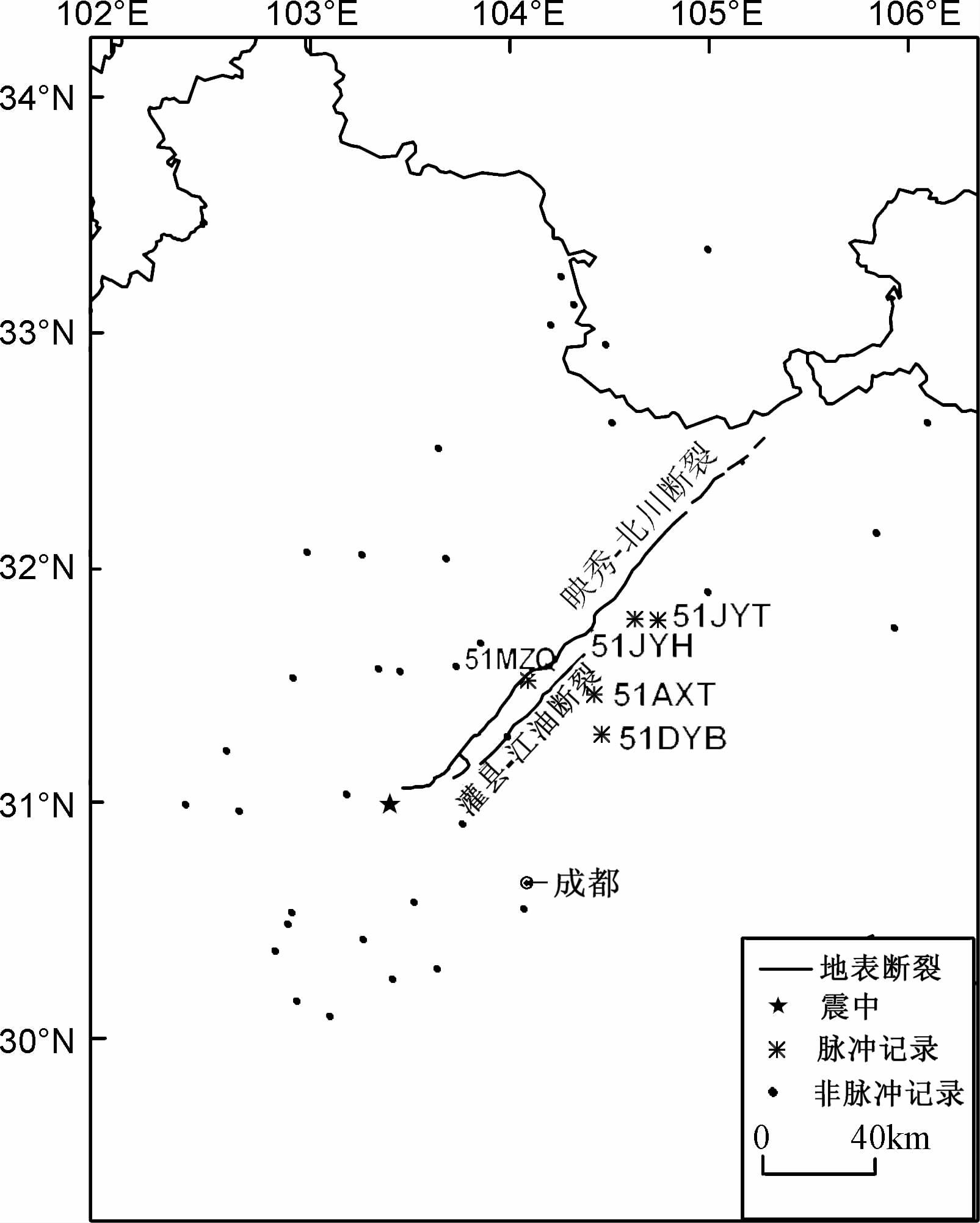
|
图 7 汶川地震地表断裂和近断层获取到脉冲型记录的强震台站位置 Fig. 7 Location of pulse-like ground motion station and rupture projection from Wenchuan earthquake |
近断层速度脉冲主要由方向性效应和地面永久位移(滑冲效应)引起,速度脉冲的主要参数与地震震源参数密切相关[13].为了对脉冲周期和脉冲幅值等参数进行统计分析,研究速度脉冲的主要参数和震源参数的关系,按照脉冲型记录的判定方法对NGA 数据库24次地震事件中的3615条记录进行统计和分类,将台站获取到的水平向记录沿断层走向分解为垂直断层分量和平行断层分量,得到脉冲判定指数大于0.85 的99 条脉冲型记录,并以此作为对脉冲周期和幅值参数进行统计分析的基础数据.
利用从汶川地震和NGA 数据库中获取到的共106条脉冲型记录数据对脉冲周期和震级的关系进行统计分析,图 8 给出了由106 条脉冲型记录数据回归得到的脉冲周期随震级变化的关系曲线.本文统计回归得到的脉冲周期随震级变化的预测关系式为

|
(4) |
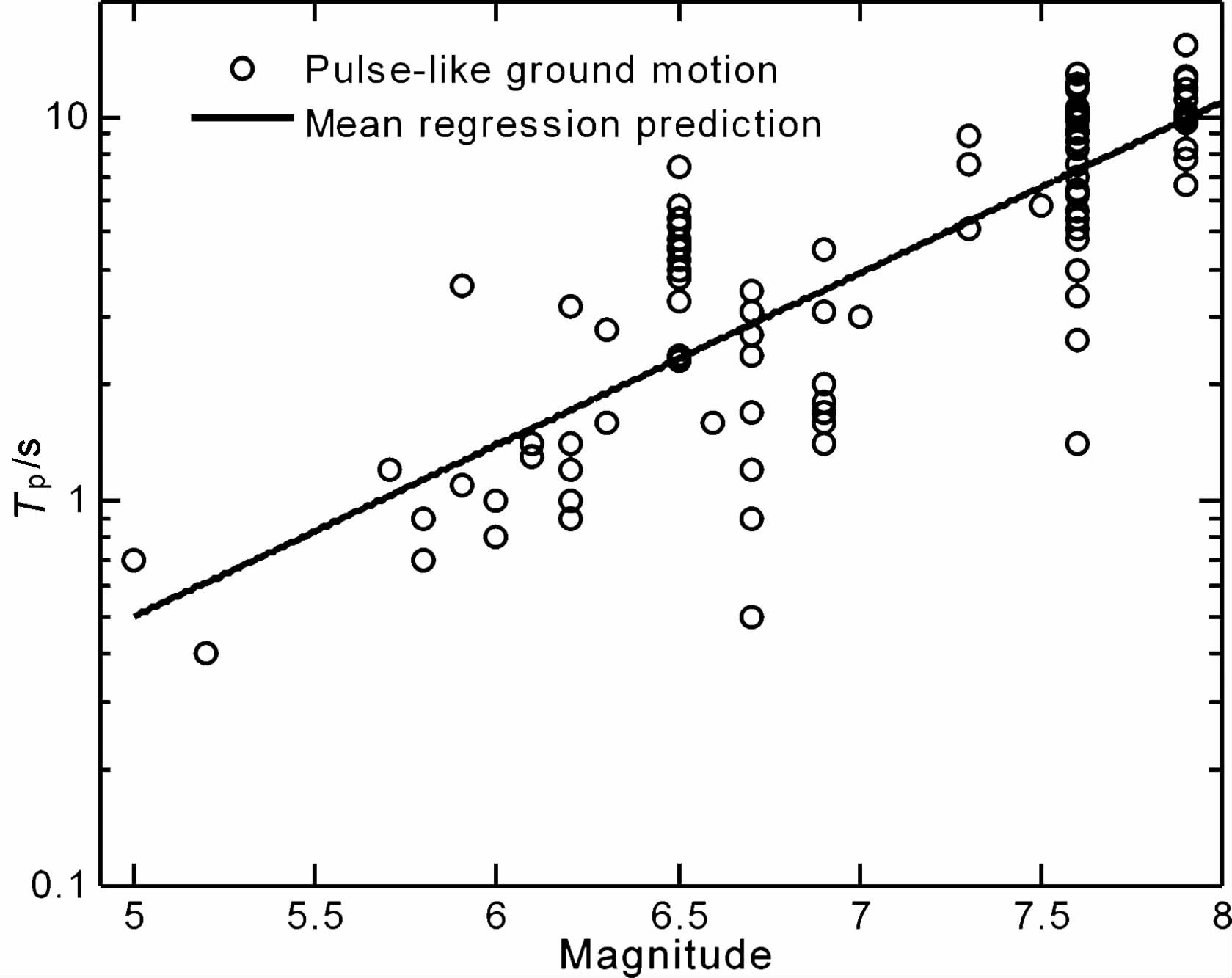
|
图 8 本文回归得到的速度脉冲周期随震级的变化关系 Fig. 8 Variation formula of pulse period (Tp) with moment magnitude (MW) obtained by regression analysis |
图 9将回归得到的脉冲周期和震级的预测模型与Alavi & Krawinkler [10],Somerville [11]以及Mavroeidis & Papageorgiou[12]给出的经验关系进行对比.由图可见,本文得到的经验模型与Mavroeidis & Papageorgiou[12]给出的经验模型最为接近,由本文模型和Mavroeidis & Papageorgiou[12]模型给出的脉冲周期预测值比Somerville [11] 、Alavi & Krawinkler [10]模型的预测值都要大,Somerville[11]和Alavi & Krawinkler[10]模型对Chi-Chi地震(Mw=7.6)和汶川地震(Mw=7.9)的脉冲周期预测值与实际脉冲周期观测值小,这一结果表明Somerville[11]和Alavi & Krawinkler [10]模型对大地震(Mw>7.5)的速度脉冲周期的预测值可能偏小.另外,本文模型在考虑了汶川地震的脉冲型记录的统计数据之后,得到的脉冲周期预测值在震级Mw>7.5时要比Mavroeidis & Papageorgiou[12]模型的预测值稍大,而在震级Mw<7.0时要比Mavroeidis & Papageorgiou[12]模型的预测值小.
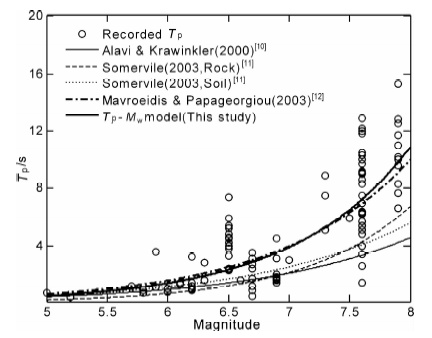
|
图 9 本文回归得到的脉冲周期和震级的经验关系与前人结果的比较 Fig. 9 Variation formula of pulse period (Tp) withmoment magnitude (MW) obtained in this study compared with former relationship |
图 10给出了Northridge地震、Chi-Chi地震和汶川地震获取到的速度脉冲随断层距的分布,将汶川地震(Mw=7.9)获取到的速度脉冲的周期与Northridge地震、Chi-Chi地震的脉冲进行比较.由统计结果可以发现,Northridge地震(Mw=6.7)的脉冲周期在1~4s 之间,比Chi-Chi地震(Mw =7.6)和汶川地震(Mw=7.9)记录到的速度脉冲的周期要小,汶川地震获取到的速度脉冲的周期在6~14s, 从整体上看,汶川地震的速度脉冲的周期比Chi-Chi地震(Mw=7.6)的脉冲周期稍大.另外,可以发现速度脉冲的周期与距离是有关系的,由这3次地震的速度脉冲的周期随断层距的分布可以看到,脉冲周期有随断层距的增大而减小的趋势.由于近断层脉冲记录数量较少,本文得到的脉冲周期与地震震级的预测关系式(4)只是由脉冲周期与矩震级数据得到的宏观统计结果,统计中假定脉冲周期与断层距无关,而图 10中给出的初步分析表明脉冲周期是受断层距影响的,因而,关于这方面的结论仍需要进一步的研究.
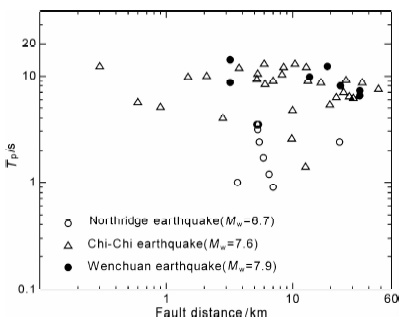
|
图 10 汶川地震、Chi-Chi地震和Northridge地震记录到的速度脉冲周期随断层距的分布 Fig. 10 Variation of pulse period (Tp) with fautt distance for distinct velocity pulses from Wenchuan earthquake compared with Chi-Chi and Northridge earthquake |
Mavroeidis & Papageorgiou[12]认为近断层脉冲的幅值在并不能无限增大,而是存在一个典型的阈值,这个阈值与典型的断层滑动速率接近,平均值在100cm/s左右.本文利用选取到的106条脉冲记录的脉冲强度幅值数据,绘出了脉冲幅值Vp 随震级和断层距变化的分布图.由图 11 可见,在矩震级Mw<7.5 时,记录到的地震动脉冲幅值在50~150cm/s, 脉冲幅值的观测结果与100cm/s的典型断层滑动速率非常接近[33-34],也与Mavroeidis & Papageorgiou[12]得出的结论一致.而对于大震(Mw>7.5),断层距10km 范围内速度脉冲的幅值已经超过100cm/s, 个别记录的脉冲幅值甚至达到200cm/s, 远超过Mavroeidis & Papageorgiou[12]给出的饱和值,这可能与大的永久形变(fling-step)或该处的土层介质条件有关.

|
图 11 脉冲强度Vp 随震级Mw 和断层距R的变化 Fig. 11 Variation of pulse amplitude (Vp) with momentmagnitude (MW) and fault distance (R) |
图 12将汶川地震观测到的速度脉冲幅值与Northridge地震、Chi-Chi地震进行比较,图中给出了这3次地震获取到的速度脉冲的幅值随断层距的分布,由图可见,虽然汶川地震震级较大,但汶川地震(Mw =7.9)要记录到的速度脉冲幅值并不比Northridge地震(Mw=6.7)和Chi-Chi地震(Mw=7.6)大,即速度脉冲幅值偏小是汶川地震的显著特点.此外,从图中可以看出,在断层距60km 范围内,速度脉冲的幅值随断层距增大衰减较快.
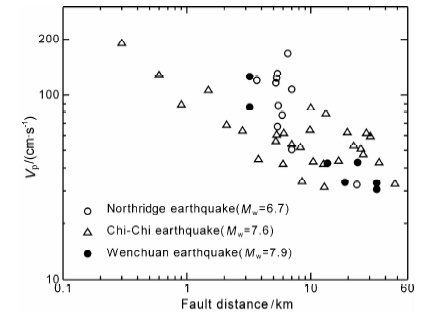
|
图 12 汶川地震观测到的脉冲强度Vp 与Chi-Chi和Northridge地震的比较 Fig. 12 Observed pulse amplitude (Vp) from Wenchuanearthquake compared with Chi - Chi and Northridge earthquake |
基于小波方法研究汶川地震近断层地震动的速度脉冲特性,通过比较汶川地震与Chi-Chi 地震、Northridge地震的速度脉冲,分析震级、距离对脉冲周期和幅值的影响,揭示了汶川地震的速度脉冲特点,研究表明:
(1) 汶川地震近断层地震动的速度脉冲具有周期长、幅值小的显著特点.速度脉冲周期主要分布在6~14s之间,其中51MZQ 台沿平行断层的分量脉冲周期最大,为14.2s, 而这次地震中记录到的速度脉冲幅值与Chi-Chi地震和Northridge地震相比明显偏小.利用地震走时与波形资料得到的反演结果表明汶川地震矩震级为7.9~8.1级,震源破裂过程在时间和空间上具有很强的不连续性,整个破裂持续时间达到约90s, 主要包含4~5 个阶段或子事件,各个阶段之间破裂滑动往往有2~4s 的“停滞"[30-31, 35-36].由此我们推断,汶川地震中近断层速度脉冲的周期较长可能主要由本次地震震级较大所决定,而脉冲幅值较小可能与地震的破裂过程不连续有关.
(2) 大幅值速度脉冲记录均位于沿着断层破裂传播的方向上,且强震记录台站与地表断裂的距离都在小于30km 的范围,这种近断层长周期速度脉冲的形成可能主要由破裂传播的向前方向性效应引起.
(3) 速度脉冲的周期随矩震级呈对数线性增大,且随断层距增大有减小趋势.在矩震级小于Mw7.5时,观测到的地震动脉冲幅值为50~150cm/s之间,与100cm/s的典型断层滑动速率非常接近;而震级大于Mw7.5时,断层距10km 范围内脉冲的幅值已经超过100cm/s, 个别记录的脉冲幅值甚至达到200cm/s, 远超过前人给出的饱和值,这可能与大的永久形变(fling-step)或该处土层介质条件有关.此外,可以发现在断层距60km 内,脉冲幅值随断层距增大衰减较快.
致谢感谢Stanford 大学的J.B.Baker教授提供的帮助,感谢中国强震动观测台网、美国PEER和台湾“中央"大学提供强震记录数据.两位匿名审稿人对本文的完善提出了许多宝贵的意见,在此一并感谢.
| [1] | Bertero V V, Mahin S A, Hrrera R A. Aseismic design implications of near-fault San Fernando earthquake records. Earthq. Eng. Struct. Dyn. , 1978, 6(1): 31-42. DOI:10.1002/(ISSN)1096-9845 |
| [2] | MacRac G A, Morrow D V, Roder C W. Near-fault ground motion effects on simple structures. J. Struct. Eng. , 2000, 127(9): 996-1004. |
| [3] | Malhotra P K. Response of buildings to near field pulse-like ground motions. Earthq. Eng. Struct. Dyn. , 1999, 28(11): 1309-1326. DOI:10.1002/(ISSN)1096-9845 |
| [4] | Iwan W D, Chen X. Important near-field ground motion data from the Landers earthquake. // Proceeding 10th European Conference on Earthquake Engineering. Vienna, Austria., 1994: 229-234. |
| [5] | Iwan W D. Drift spectrum: measure of demand for earthquake ground motions. J. Struct. Eng. , 1997, 123(4): 397-404. DOI:10.1061/(ASCE)0733-9445(1997)123:4(397) |
| [6] | Somerville P. Characterization of ground motion at the sites of subjected buildings. SAC Joint Venture Rep, 1995, SAC 95-03. |
| [7] | Somerville P G, Smith N F, Graves R W, et al. Modification of empirical strong ground motion attenuation relations to include the amplitude and duration effects of rupture directivity. Seism. Res. Lett. , 1997, 68(1): 199-222. DOI:10.1785/gssrl.68.1.199 |
| [8] | Huang B S, Chen K C, Wang W G, et al. Characteristics of strong ground motion across a thrust fault tip from the September 21, 1999, Chi-Chi, Taiwan earthquake. Geophys. Res. Lett. , 2000, 27(17): 2729-2732. DOI:10.1029/2000GL011396 |
| [9] | Chen K C, Huang B S, Wang J H, et al. An observation of rupture pulses of the 20 September 1999 Chi-Chi, Taiwan, earthquake from near-field seismograms. Bull. Seism. Soc. Am. , 2001, 91(5): 1247-1254. |
| [10] | Alavi B, Krawinkler H. Consideration of near-fault ground motion effects in seismic design. // Proceedings 6th World Conference on Earthquake Engineering. New Zealand: The New Zealand Society for Earthquake Engineering. 2000, 2665: 1-8. |
| [11] | Somerville P G. Magnitude scaling of the near fault directivity pulse. Phy. Earth Planet. Int. , 2003, 137(1-4): 201-212. DOI:10.1016/S0031-9201(03)00015-3 |
| [12] | Mavroeidis G P, Papageorgiou A S. A mathematical representation of near-fault ground motions. Bull. Seism. Soc. Am. , 2003, 93(3): 1099-1131. DOI:10.1785/0120020100 |
| [13] | Bray J D, Rodriguez-Marek A. Characterization of forward directivity ground motions in the near-fault region. Soil Dyn. & Earthq. Eng. , 2004, 24(11): 815-828. |
| [14] | 韦韬, 赵凤新, 张郁山. 近断层速度脉冲的地震动特性研究. 地震学报 , 2006, 28(6): 629–637. Wei T, Zhao F X, Zhang Y S. Characteristics of near-fault ground motion containing velocity pulses. Acta Seismologica Sinica (in Chinese) , 2006, 28(6): 629-637. |
| [15] | Baker J W. Quantitative classification of near-fault ground motions using wavelet analysis. Bull. Seism. Soc. Am. , 2007, 97(5): 1486-1501. DOI:10.1785/0120060255 |
| [16] | Li X J, Zhou Z H, Huang M, et al. Preliminary analysis of strong-motion recordings from the magnitude 8.0 Wenchuan, China, earthquake of May 12. Seism. Res. Lett. , 2008, 79(6): 844-854. DOI:10.1785/gssrl.79.6.844 |
| [17] | Li X J, Liu L, Wang Y S, et al. Analysis of horizontal strong-motion attenuation in the great 2008 Wenchuan earthquake. Bull. Seism. Soc. Am. , 2010, 100(5B): 2440-2449. DOI:10.1785/0120090245 |
| [18] | 于海英, 王栋, 杨永强, 等. 汶川8.0级地震强震动特征初步分析. 震灾防御技术 , 2008, 3(4): 321–336. Yu H Y, Wang D, Yang Y Q, et al. The preliminary analysis of strong ground motion characteristics from the Ms8.0 Wenchuan earthquake, China. Technology for Earthquake Disaster Prevention (in Chinese) , 2008, 3(4): 321-336. |
| [19] | Lu M, Li X J, An X W, et al. A preliminary study on the near-source strong-motion characteristics of the great 2008 Wenchuan earthquake in China. Bull. Seism. Soc. Am. , 2010, 100(5B): 2491-2507. DOI:10.1785/0120090132 |
| [20] | Wen Z P, Xie J J, Gao M T, et al. Near-source ground motion characteristics of the Ms8.0 Wenchuan earthquake. Bull. Seism. Soc. Am. , 2010, 100(5B): 2425-2439. DOI:10.1785/0120090266 |
| [21] | 谢俊举, 温增平, 高孟潭, 等. 2008年汶川地震近断层地震动的非平稳特征. 地球物理学报 , 2011, 54(3): 728–736. Xie J J, Wen Z P, Gao M T, et al. Non-stationary characteristics of near-fault strong motions during the 2008 Wenchuan earthquake. Chinese J. Geophys. (in Chinese) , 2011, 54(3): 728-736. |
| [22] | 朱继梅. 小波变换及其工程应用. 振动与冲击 , 1996, 15(4): 94–100. Zhu J M. Wavelet transform and its engineering applications. Journal of Vibration and Shock (in Chinese) , 1996, 15(4): 94-100. |
| [23] | 石春香, 罗奇峰. 时程信号的Hilbert-Huang变换与小波分析. 地震学报 , 2003, 25(4): 398–405. Shi C X, Luo Q F. Hilbert-Huang transform and wavelet analysis of time history signal. Acta Seismologica Sinica (in Chinese) , 2003, 25(4): 398-405. |
| [24] | 赵凤新, 韦韬, 张郁山. 近断层速度脉冲对钢筋混凝土框架结构地震反应的影响. 工程力学 , 2008, 25(10): 180–187. Zhao F X, Wei T, Zhang Y S. Influence of near-fault velocity pulse on the seismic response of reinforced concrete frame. Engineering Mechanics (in Chinese) , 2008, 25(10): 180-187. |
| [25] | 杨迪雄, 李刚, 程耿东. 近断层脉冲型地震动作用下隔震结构地震反应分析. 地震工程与工程振动 , 2005, 25(2): 119–124. Yang D X, Li G, Cheng G D. Seismic analysis of base-isolated structures subjected to near-fault pulse-like ground motions. Earthquake Engineering & Engineering Vibration (in Chinese) , 2005, 25(2): 119-124. |
| [26] | 杨迪雄, 潘建伟, 李刚. 近断层脉冲型地震动作用下建筑结构的层间变形分布特征和机理分析. 建筑结构学报 , 2009, 30(4): 108–118. Yang D X, Pan J W, Li G. Deformational distribution feature and mechanism analysis of building structures subjected to near-fault pulse-type ground motions. Journal of Building Structures (in Chinese) , 2009, 30(4): 108-118. |
| [27] | Anderson J C, Bertero V V. Uncertainties in establishing design earthquakes. J. Struct. Eng., ASCE , 1987, 113(8): 1709-1724. DOI:10.1061/(ASCE)0733-9445(1987)113:8(1709) |
| [28] | Hall J F, Heaton T H, Halling M W, et al. Near-source ground motion and its effects on flexible buildings. Earthquake Spectra , 1995, 11(4): 569-604. DOI:10.1193/1.1585828 |
| [29] | Makris N. Rigidity-plasticity-viscosity: can electrorheological dampers protect base-isolated structures from near-source ground motions?. Earthq. Eng. Struct. Dyn. , 1997, 26(5): 571-591. DOI:10.1002/(ISSN)1096-9845 |
| [30] | 王卫民, 赵连锋, 李娟, 等. 四川汶川8.0级地震震源过程. 地球物理学报 , 2008, 51(5): 1403–1410. Wang W M, Zhao L F, Li J, et al. Rupture process of the Ms8.0 Wenchuan earthquake of Sichuan, China. Chinese J. Geophys. (in Chinese) , 2008, 51(5): 1403-1410. |
| [31] | 张勇, 冯万鹏, 许力生, 等. 2008年汶川大地震的时空破裂过程. 中国科学-D辑: 地球科学 , 2008, 38(10): 1186–1194. Zhang Y, Feng W P, Xu L S, et al. Spatial-temporal rupture process of the 2008 great Wenchuan earthquake. Science in China Series D-Earth Sciences (in Chinese) , 2008, 38(10): 1186-1194. |
| [32] | 徐锡伟, 闻学泽, 叶建青, 等. 汶川Ms8.0地震地表破裂带及其发震构造. 地震地质 , 2008, 30(3): 597–627. Xu X W, Wen X Z, Ye J Q, et al. Discovery of the Wenchuan Ms8.0 earthquake surface ruptures and discussion for its seismogenic structures. Seismology and Geology (in Chinese) , 2008, 30(3): 597-627. |
| [33] | Brune J N. Tectonic stress and the spectra of seismic shear waves from earthquakes. J. Geophys. Res. , 1970, 75(26): 4997-5009. DOI:10.1029/JB075i026p04997 |
| [34] | Aki K. Strong-motion seismology, in earthquakes: observation, theory and interpretation. // Kanamori H, Boschi E, eds. Proceeding of the International School of Physics, 'Enrico Fermi’. Amsterdam: North-Holland, 1983, 85: 223-250. |
| [35] | 赵翠萍, 陈章立, 周连庆, 等. 汶川Mw8.0级地震震源破裂过程研究: 分段特征. 科学通报 , 2009, 54(22): 3475–3482. Zhao C P, Chen Z L, Zhou L Q, et al. Rupture process of the 8.0 Wenchuan earthquake of Sichuan, China: the segmentation feature. Chinese Sci. Bull. (in Chinese) , 2009, 54(22): 3475-3482. |
| [36] | 杜海林, 许力生, 陈运泰. 利用阿拉斯加台阵资料分析2008年汶川大地震的破裂过程. 地球物理学报 , 2009, 52(2): 372–378. Du H L, Xu L S, Chen Y T. Rupture process of the 2008 great Wenchuan earthquake from the analysis of the Alaska array data. Chinese J. Geophys. (in Chinese) , 2009, 52(2): 372-378. |
 2012, Vol. 55
2012, Vol. 55



